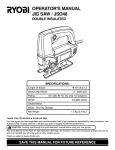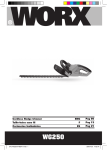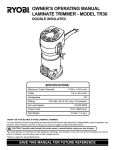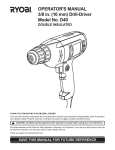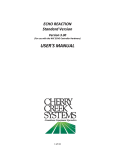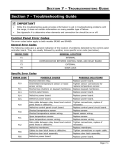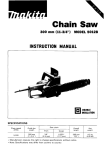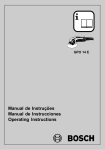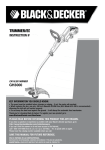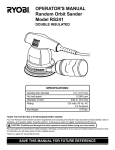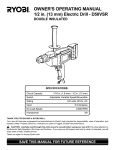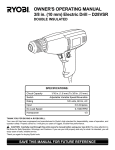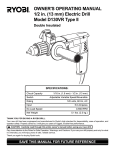Download Ryobi HD500 Specifications
Transcript
OWNER'S OPERATING MANUAL 1/2 in. (13 mm) Hammer Drill - HD500 DOUBLE INSULATED SPECIFICATIONS: Chuck Capacity Horsepower Rating 5/64 in. (2 mm) - 1/2 in. (13 mm) 3/8 220 volts, 50 Hz, AC only, 1.75 Amperes No Load Speed 0-1200 RPM Hammer Speed 0-19,200 BPM Hammer Travel .025 Switch Adjustable Variable Speed/Reversible THANK YOU FOR BUYING A RYOBI HAMMER DRILL. Your new hammer drill has been engineered and manufactured to Ryobi's high standard for dependability, ease of operation, and operator safety. Properly cared for, it will give you years of rugged, trouble-free performance. CAUTION: Carefully read through this entire owner's manual before using your new hammer drill. Pay close attention to the Rules for Safe Operation, Warnings, and Cautions. If you use your hammer drill properly and only for what it is intended, you will enjoy years of safe, reliable service. Thank you again for buying Ryobi tools. SAVE THIS MANUAL FOR FUTURE REFERENCE TABLE OF CONTENTS 1. 2. 3. 4 5. 6. Product Specifications ................................................................................... 1 Table Of Contents .......................................................................................... 2 Rules For Safe Operation ........................................................................... 2-4 Operation ...................................................................................................5-11 Maintenance ................................................................................................ 12 Parts Ordering / Service............................................................................... 14 RULES FOR SAFE OPERATION The purpose of safety symbols is to attract your attention to possible dangers. The safety symbols, and the explanations with them, deserve your careful attention and understanding. The safety warnings do not by themselves eliminate any danger. The instructions or warnings they give are not substitutes for proper accident prevention measures. SYMBOL MEANING SAFETY ALERT SYMBOL: Indicates caution or warning. May be used in conjunction with other symbols or pictographs. WARNING: Failure to obey a safety warning can result in serious injury to yourself or to others. Always follow the safety precautions to reduce the risk of fire, electric shock and personal injury. CAUTION: Failure to obey a safety warning may result in property damage or personal injury to yourself or to others. Always follow the safety precautions to reduce the risk of fire, electric shock and personal injury. NOTE: Advises you of information or instructions vital to the operation or maintenance of the equipment. DOUBLE INSULATION IMPORTANT Your Ryobi power tool is double insulated. This means you are separated from the tool's electrical system by two complete sets of electrical insulation. This extra layer of insulation is intended to protect the user from electrical shock due to a break in the wiring insulation. All exposed metal parts are isolated from the internal metal motor components with protecting insulation. Double insulated tools do not need to be grounded. Servicing of a tool with double insulation requires extreme care and knowledge of the system and should be performed only by a qualified service technician. For service we suggest you return the tool to your nearest RYOBI FACTORY SERVICE CENTER or other AUTHORIZED SERVICE ORGANIZATION for repair. When servicing use only identical Ryobi replacement parts. WARNING: WARNING: The double insulated system is intended to protect the user from shock resulting from a break in the tool's internal wiring. Observe all normal safety precautions related to avoiding electrical shock. Page 2 Do not attempt to operate this tool until you have read thoroughly and understand completely all instructions, safety rules, etc. contained in this manual. Failure to comply can result in accidents involving fire, electric shock, or serious personal injury. Save owner's manual and review frequently for continuing safe operation, and instructing others who may use this tool. READ ALL INSTRUCTIONS 1. KNOW YOUR POWER TOOL. Read owner's manual carefully. Learn its applications and limitations as well as the specific potential hazards related to this tool. 2. GUARD AGAINST ELECTRICAL SHOCK by preventing body contact with grounded surfaces. For example: Pipes, radiators, ranges, refrigerator enclosures. 3. KEEP GUARDS IN PLACE and in working order. 4. KEEP WORK AREA CLEAN. Cluttered areas and benches invite accidents. 5. AVOID DANGEROUS ENVIRONMENT. Don't use power tool in damp or wet locations or expose to rain. Keep work area well lit. 6. KEEP CHILDREN AND VISITORS AWAY. All visitors should wear safety glasses and be kept a safe distance from work area. Do not let visitors contact tool or extension cord. 7. STORE IDLE TOOLS. When not in use tools should be stored in a dry and high or lockedup place - out of the reach of children. 8. DON'T FORCE TOOL. It will do the job better and safer at the rate for which it was designed. 9. USE RIGHT TOOL. Don't force small tool or attachment to do the job of a heavy duty tool. Don't use tool for purpose not intended - for example - A circular saw should never be used for cutting tree limbs or logs. 10. WEAR PROPER APPAREL. Do not wear loose clothing or jewelry that can get caught in the tool's moving parts and cause personal injury. Rubber gloves and nonskid footwear are recommended when working outdoors. Wear protective hair covering to contain long hair and keep it from being drawn into nearby air vents. 11. ALWAYS WEAR SAFETY GLASSES. Everyday eyeglasses have only impactresistant lenses; they are NOT safety glasses. 12. PROTECT YOUR LUNGS. Wear a face or dust mask if operation is dusty. 13. PROTECT YOUR HEARING. Wear hearing protection during extended periods of operation. 14. DON'T ABUSE CORD. Never carry tool by cord or yank it to disconnect from receptacle. Keep cord from heat, oil and sharp edges. 15. SECURE WORK. Use clamps or a vise to hold work. Both hands are needed to operate the tool. 16. DON'T OVERREACH. Keep proper footing and balance at all times. Do not use on a ladder or unstable support. 17. MAINTAIN TOOLS WITH CARE. Keep tools sharp at all times, and clean for best and safest performance. Follow instructions for lubricating and changing accessories. 18. DISCONNECT TOOLS. When not in use, before servicing, or when changing attachments, blades, bits, cutters, etc., all tools should be disconnected from power supply. 19. REMOVE ADJUSTING KEYS AND WRENCHES. Form habit of checking to see that keys and adjusting wrenches are removed from tool before turning it on. 20. AVOID ACCIDENTAL STARTING. Don't carry plugged-in tools with finger on switch. Be sure switch is off when plugging in. 21. MAKE SURE YOUR EXTENSION CORD IS IN GOOD CONDITION. When using an extension cord, be sure to use one heavy enough to carry the current your product will draw. An undersized cord will cause a drop in line voltage resulting in loss of power and overheating. A wire gage size (A.W.G.) of at least 16 is recommended for an extension cord 100 feet or less in length. A cord exceeding 100 feet is not recommended. If in doubt, use the next heavier gage. The smaller the gage number, the heavier the cord. 22. OUTDOOR USE EXTENSION CORDS. When tool is used outdoors, use only extension cords suitable for use outdoors. Outdoor approved cords are marked with the suffix W-A, for example - SJTW-A or SJOW-A. 23. KEEP BITS CLEAN AND SHARP. Sharp bits minimize stalling and kickback. Page 3 RULES FOR SAFE OPERATION (Continued) 24. KEEP HANDS AWAY FROM DRILLING AREA. Keep hands away from bits. Do not reach underneath work while bit is rotating. Do not attempt to remove material while bit is rotating. 25. NEVER USE IN AN EXPLOSIVE ATMOSPHERE. Normal sparking of the motor could ignite fumes. 26. INSPECT TOOL CORDS PERIODICALLY and if damaged, have repaired at your nearest FACTORY SERVICE CENTER or other AUTHORIZED SERVICE CENTER. Stay constantly aware of cord location. 27. INSPECT EXTENSION CORDS PERIODICALLY and replace if damaged. 28. KEEP HANDLES DRY, CLEAN, AND FREE FROM OIL AND GREASE. Always use a clean cloth when cleaning. Never use brake fluids, gasoline, petroleum-based products or any strong solvents to clean your tool. 29. STAY ALERT. Watch what you are doing and use common sense. Do not operate tool when you are tired. Do not rush. 30. CHECK DAMAGED PARTS. Before further use of the tool, a guard or other part that is damaged should be carefully checked to determine that it will operate properly and perform its intended function. Check for alignment of moving parts, binding of moving parts, breakage of parts, mounting, and any other conditions that may affect its operation. A guard or other part that is damaged should be properly repaired or replaced by an 31. 32. 33. 34. 35. 36. 37. authorized service center unless indicated elsewhere in this instruction manual. DO NOT USE TOOL IF SWITCH DOES NOT TURN IT ON AND OFF. Have defective switches replaced by an authorized service center. DRILLING INTO ELECTRICAL WIRING IN WALLS CAN CAUSE DRILL BIT AND CHUCK TO BECOME ELECTRICALLY LIFE. Do not touch the chuck or metal housing when drilling into a wall; grasp only the insulated handle(s) provided on the tool. INSPECT FOR and remove all nails from lumber before drilling. DRUGS, ALCOHOL, MEDICATION. Do not operate tool while under the influence of drugs, alcohol, or any medication. WHEN SERVICING USE ONLY IDENTICAL RYOBI REPLACEMENT PARTS. POLARIZED PLUGS. To reduce the risk of electric shock, this tool has a polarized plug (one blade is wider than the other). This plug will fit in a polarized outlet only one way. If the plug does not fit fully in the outlet, reverse the plug. If it still does not fit, contact a qualified electrician to install the proper outlet. Do not change the plug in any way. SAVE THESE INSTRUCTIONS. Review them frequently and use them to instruct others who may use this tool. If you loan someone this tool, loan them these instructions also. WARNING: WEAR YOUR The operation of any hammer drill can result in foreign objects being thrown into your eyes, which can result in severe eye damage. Before beginning power tool operation, always wear safety goggles or safety glasses with side shields and a full face shield when needed. We recommend Wide Vision Safety Mask for use over eyeglasses or FORESIGHT IS BETTER standard safety glasses with side shields. THAN NO SIGHT SAFETY GLASSES Look for this symbol to point out important safety precautions. It means attention!!! Your safety is involved. Page 4 OPERATION KNOW YOUR HAMMER DRILL APPLICATIONS See Figure 1. Before attempting to use your hammer drill, familiarize yourself with all operating features and safety requirements. (Use only for the purposes listed below) 1. Hammer drilling in concrete and masonry. 2. Drilling in wood. 3. Drilling in ceramics, plastics, fiberglass, and laminates. 4. Drilling in both hard and soft metals. WARNING: If any parts are missing do not operate your hammer drill until the missing parts are replaced. Failure to do so could result in possible serious injury. 5. Using driving accessories, such as driving screws with screwdriver bits. 6. Mixing paints. AUXILIARY HANDLE DEPTH GAGE ROD DEPTH GAGE CLAMP CHUCK TO STORE CHUCK KEY STORAGE VARIABLE SPEED CONTROL SELECTOR LOCK-ON BUTTON SWITCH TRIGGER CHUCK KEY TO REMOVE Fig. 1 ELECTRICAL CONNECTION WARNING: Do not allow familiarity with your hammer drill to make you careless. Remember that a careless fraction of second is sufficient to inflict severe injury. Your hammer drill has a precision built Ryobi electric motor. It should be connected to a power supply that is 220 volts, 50 Hz only. Do not operate this tool on direct current (DC). A voltage drop of more than 10 percent will cause a loss of power and the motor will overheat. If this tool does not operate when plugged into an outlet, double-check the power supply. Page 5 OPERATION SWITCH LOCK-ON BUTTON See Figure 2. To turn your hammer drill ON, depress the switch trigger. Release switch trigger to turn your hammer drill OFF. LOCK-ON BUTTON See Figure 2. Your hammer drill is equipped with a "lock-on" feature, which is convenient when continuous drilling for extended periods of time is required. To lock-on, depress the switch trigger, push in and hold the lock-on button located on the side of the handle, then release switch trigger. Release lock-on button and your drill will continue running. To release the lock, depress the switch trigger and release it. If you have the "lock-on" feature engaged during use and your drill becomes disconnected from power supply, disengage the "lock-on" feature immediately. WARNING: SWITCH TRIGGER FORWARD-REVERSE LEVER Fig. 2 FORWARD Before connecting your hammer drill to power supply source, always check to be sure it is not in “lock-on” position (depress and release switch trigger). Failure to do so could result in accidental starting of your drill resulting in possible serious injury. Also, do not lock the trigger on jobs where your drill may need to be stopped suddenly. REVERSIBLE See Figure 3. Your hammer drill has the feature of being reversible. The direction of chuck rotation is controlled by a lever located above the switch trigger. With your drill held in normal operating position, the direction of rotation lever should be positioned to the left of the switch for drilling operation. The direction of rotation is reversed when the lever is to the right of the switch. The design of the switch will not permit changing the direction of rotation while the drill is running. Release the switch trigger and allow the drill to stop before changing its direction. NOTE: Your hammer drill will not run unless switch lever is pushed fully to the left or right. REVERSE Fig. 3 TO STORE CHUCK KEY STORAGE CHUCK KEY See Figure 4. A chuck key has been provided for use when installing or removing bits. It is also used when removing the chuck. (See chuck removal section). CHUCK KEY STORAGE See Figure 4. When not in use, the chuck key can be placed in the storage area located on the bottom portion of drill handle. Page 6 TO REMOVE Fig. 4 OPERATION VARIABLE SPEED See Figure 5. Your hammer drill has a variable speed control selector designed to allow operator control and adjustment of speed and torque limits. Speed and torque can be increased or decreased by rotating the variable speed control selector in the direction of the arrows shown in figure 5. NOTE: Hold your hammer drill in normal operating position and turn the variable speed control selector clockwise to increase the speed and torque of your hammer drill. Turn counterclockwise to decrease the speed and torque of your hammer drill. If you desire to lock the switch on at a given speed, depress the switch trigger, push in and hold the lock-on button, and release the switch trigger. Next, adjust the variable speed control selector until the desired speed is reached. NOTE: If the variable speed control selector is fully turned in the counterclockwise direction (zero setting) your drill may not run. If you desire not to use the variable speed control selector, turn it in the full clockwise direction. This will allow the speed of your drill to be fully controlled by the amount of switch trigger depression. Avoid running your hammer drill at low speeds for extended periods of time. Running at low speeds under constant usage may cause your drill to become overheated. If this occurs, cool your drill by running it without a load and at full speed. The following guidelines may be used in determining correct speed for various applications: LOW speed is ideal when minimum speed and power is required. For example: starting holes without center punching, driving screws, mixing paint, and drilling in ceramics. MEDIUM speed is suitable for drilling hard metals, plastics, and laminates. HIGH speed produces best results when maximum power is required. For example: drilling in wood; soft metals such as aluminum, brass, and copper; and when using driving accessories. INSTALLING AUXILIARY HANDLE See Figure 6. An auxiliary handle is packed with your hammer drill for ease of operation and to help prevent loss of control. NOTE: For convenience the screw has been trapped inside the auxiliary handle. 1. Remove depth gage clamp and auxiliary handle from plastic bag in hammer drill box. 2. Orient depth gage clamp so that the tabs will fit into motor housing of hammer drill. 3. Thread depth gage clamp onto auxiliary handle until it reaches undercut area of screw threads. Undercut of screw threads will keep depth gage clamp on auxiliary handle, preventing it from getting lost. Page 7 VARIABLE SPEED CONTROL SELECTOR TO INCREASE SPEED TO DECREASE SPEED Fig. 5 AUXILIARY HANDLE DEPTH GAGE CLAMP TABS SLOTS DEPTH GAGE ROD MOTOR HOUSING Fig. 6 OPERATION INSTALLING AUXILIARY HANDLE (Continued) 4. Align tabs on depth gage clamp with slots in threaded hole in motor housing. NOTE: Depth gage clamp can be rotated 180° so that depth gage rod will fit on either side of motor housing. 5. Carefully start the fine screw threads (#3/8-24) into fine threaded hole in motor housing and tighten securely. DO NOT cross thread handle bolt in motor housing. To prevent thread damage and possible loss of control, auxiliary handle should be checked periodically for tightness. DO NOT operate hammer drill with handle loose or with depth gage clamp removed. In addition to securing depth gage rod to your hammer drill, depth gage clamp also provides the proper amount of handle screw thread engagement when depth gage rod is not being used. TO LOOSEN AUXILIARY HANDLE AND CLAMP TO INCREASE DRILLING DRILLING DEPTH DEPTH TO DECREASE DRILLING DEPTH DEPTH GAGE CLAMP TO TIGHTEN AUXILIARY HANDLE AND CLAMP DEPTH GAGE ROD USING DEPTH GAGE ROD See Figure 7. A depth gage rod has been packed with your hammer drill to assist you in controlling the depth of drilled holes. 1. Install depth gage rod thru depth gage clamp as shown in figure 7. 2. Adjust depth gage rod so that the drill bit extends beyond the end of the rod to the required drilling depth. 3. Securely tighten auxiliary handle against depth gage clamp. This secures depth gage rod at desired depth of cut. It also secures auxiliary handle. When drilling holes with the depth gage rod installed, the desired hole depth has been reached when the end of the rod comes in contact with the surface of the material being drilled. DRILL BIT Fig. 7 PUSH UP FOR HAMMER MODE TO ADJUST DRILLING MODE See Figure 8. To adjust for type of drilling, slide adjustment button on side of motor housing up to hammer mode or down to drilling mode. For your convenience a hammer symbol and drill bit symbol have been molded into adjustment button. NOTE: Adjustment button may be difficult to slide when changing drilling modes. If this situation occurs, turn you hammer drill on and slide adjustment button while drill is running. PUSH DOWN FOR DRILLING MODE WARNING: ADJUSTMENT BUTTON Your hammer drill has not been designed for reverse hammering. We recommend that you use carbide-tipped bits and select hammer mode when drilling in hard materials such as brick, tile, concrete, etc. We recommend that you select normal drill mode when drilling with twist drills, hole saws, etc. in soft materials. Page 8 Fig. 8 OPERATION WARNING: DRILL BIT Your hammer drill should never be connected to power supply when you are assembling parts, making adjustments, installing or removing drill bits, or when not in use. Disconnecting your drill will prevent accidental starting that could cause serious injury. TO INSTALL BITS See Figure 9. 1. UNPLUG YOUR HAMMER DRILL. CHUCK JAWS WARNING: Failure to unplug your hammer drill could result in accidental starting causing serious injury. RIGHT Fig. 9 2. Open or close the chuck jaws to a point where the opening is slightly larger than the drill bit you intend to use. Also, raise the front of your drill slightly to keep the drill bits from falling out of the chuck jaws. 3. Insert drill bit into chuck the full length of the jaws. WARNING: Do not insert drill bit into chuck jaws and tighten as shown in figure 10. This could cause drill bit to be thrown from your drill resulting in possible serious personal injury or damage to your chuck. 4. Tighten the chuck jaws securely on drill bit, using only the chuck key provided. Do not use a wrench to tighten or loosen the chuck jaws. 5. Remove chuck key and return to storage area. TO REMOVE BITS 1. UNPLUG YOUR HAMMER DRILL. WARNING: Failure to unplug your hammer drill could result in accidental starting causing serious injury. 2. Loosen the chuck jaws using only the chuck key provided. Do not use a wrench to tighten or loosen the chuck jaws. 3. Remove drill bit from chuck jaws. 4. Remove chuck key and return to storage area. Page 9 WRONG Fig. 10 OPERATION WARNING: Always wear safety goggles or safety glasses with side shields when operating hammer drill. Failure to do so could result in dust, shavings, or loose particles being thrown into your eyes, resulting in possible serious injury. DRILLING See Figure 11. 1. Depress and release the switch trigger to be sure your drill is in OFF position before connecting it to power supply. 2. Check the direction of rotation lever for correct setting (forward or reverse). See Figure 3, Page 6. 3. Secure the material to be drilled in a vise or with clamps to keep it from turning as the drill bit rotates. 4. Plug your hammer drill into power supply source. 5. Hold your drill firmly and place the bit at the point to be drilled. 6. Depress the switch trigger to start your drill. Do not lock the switch ON for jobs where your drill may need to be stopped suddenly. 7. Move the drill bit into the workpiece applying only enough pressure to keep the bit cutting. Do not force your drill or apply side pressure to elongate a hole. Let your drill and bit do the work. See Figure 11. WARNING: Fig. 11 Be prepared for binding or breakthrough. When these situations occur, drill has a tendency to grab and kick in the opposite direction and could cause loss of control when breaking through material. If not prepared, this loss of control can result in possible serious injury. When drilling hard, smooth surfaces use a center punch to mark the desired hole location. This will prevent the drill bit from slipping off center as the hole is started. However, the variable speed feature allows starting holes without center punching if desired. To accomplish this, operate your drill at a low speed until the hole is started. When drilling metals use a light oil on the drill bit to keep it from overheating. The oil will prolong the life of the bit and increase the drilling action. If the bit jams in the workpiece or if your drill stalls, stop the tool immediately. Remove the bit from the workpiece and determine the reason for jamming. Page 10 OPERATION CHUCK REMOVAL MALLET See Figures 12, 13, and 14. Whenever necessary to remove the chuck for replacement, etc., use the following procedure for chuck removal: CHUCK 1. UNPLUG YOUR HAMMER DRILL. WARNING: Failure to unplug your hammer drill could result in accidental starting causing serious injury. 2. Open chuck jaws. Insert a 5/16 inch or larger hex key wrench (allen wrench) into the chuck of your drill and tighten the chuck jaws securely. 3. Tap the hex key wrench sharply with a mallet in a clockwise direction. See Figure 12. This will loosen the chuck screw for removal. 4. Open the chuck jaws and remove hex key wrench. Remove the chuck screw by turning it in a clockwise direction. See Figure 13. NOTE: The chuck screw has left hand threads. 5. Insert hex key wrench in chuck and tighten chuck jaws securely. Tap sharply with a mallet in a counterclockwise direction. This will loosen the chuck on the spindle. It can now be unscrewed by hand. See Figure 14. CHUCK JAWS HEX KEY WRENCH (ALLEN WRENCH) Fig. 12 SCREWDRIVER TO RETIGHTEN A LOOSE CHUCK The chuck may at times become loose on the spindle and develop a wobble. Also, the chuck screw may become loose causing the chuck jaws to bind and prevent them from closing. To tighten, follow these steps: Fig. 13 1. UNPLUG YOUR HAMMER DRILL. WARNING: MALLET Failure to unplug your hammer drill could result in accidental starting causing serious injury. 2. Insert hex key wrench into chuck and tighten chuck jaws securely. Tap allen wrench sharply with a mallet in a clockwise direction. This will tighten the chuck on the spindle. See Figure 12. 3. Open the chuck jaws and remove hex key wrench. 4. Tighten the chuck screw. NOTE: The chuck screw has left hand threads. See Figure 13. CHUCK HEX KEY WRENCH (ALLEN WRENCH) CHUCK REMOVAL Page 11 Fig. 14 MAINTENANCE WARNING: When servicing use only identical Ryobi replacement parts. Use of any other parts may create a hazard or cause product damage. GENERAL Avoid using solvents when cleaning plastic parts. Most plastics are susceptible to damage from various types of commercial solvents and may be damaged by their use. Use clean cloths to remove dirt, carbon dust, etc. When electric tools are used on fiberglass boats, sports cars, wallboard, spackling compounds, or plaster, it has been found that they are subject to accelerated wear and possible premature failure, as the fiberglass chips and grindings are highly abrasive to bearings, brushes, commutators, etc. Consequently it is not recommended that this tool be used for extended work on any fiberglass material, wallboard, spackling compounds, or plaster. During any use on fiberglass it is extremely important that the tool is cleaned frequently by blowing with an air jet. WARNING: Always wear safety goggles or safety glasses with side shields during power tool operation or when blowing dust. If operation is dusty, also wear a dust mask. WARNING: Do not at any time let brake fluids, gasoline, petroleumbased products, penetrating oils, etc. come in contact with plastic parts. They contain chemicals that can damage, weaken, or destroy plastic. EXTENSION CORDS The use of any extension cord will cause some loss of power. To keep the loss to a minimum and to prevent tool from overheating, use an extension cord that is heavy enough to carry the current the tool will draw. A wire gage size (A.W.G.) of at least 16 is recommended for an extension cord 100 feet or less in length. When working outdoors, use an extension cord that is suitable for outdoor use. The cord's jacket will be marked WA. WARNING: Check extension cords before each use. If damaged replace immediately. Never use tool with a damaged cord since touching the damaged area could cause electrical shock resulting in serious injury. WARNING: CAUTION: Keep extension cords away from the drilling area and position the cord so that it will not get caught on lumber, tools, etc., during drilling operation. Do not use this product as a component of other products. Also, do not use attachments or accessories not recommended for use with this product. Any such use could result in possible serious personal injury. LUBRICATION All of the bearings in this tool are lubricated with a sufficient amount of high grade lubricant for the life of the unit under normal operating conditions. Therefore, no further lubrication is required. Page 12 NOTES Page 13 OWNER'S OPERATING MANUAL 1/2 in. (13 mm) Hammer Drill - HD500 DOUBLE INSULATED • SERVICE Now that you have purchased your tool, should a need ever exist for repair parts or service, simply contact your nearest Ryobi Factory Service Center or Authorized Service Organization. Be sure to provide all pertinent facts when you call or visit. • MODEL NO. AND SERIAL NO. The model number of this tool will be found on a plate attached to the motor housing. Please record the model number and serial number in the space provided below. • HOW TO ORDER REPAIR PARTS WHEN ORDERING REPAIR PARTS, ALWAYS GIVE THE FOLLOWING INFORMATION: 972000-401 8-97 • MODEL NUMBER • SERIAL NUMBER HD500 Printed In U.S.A.














